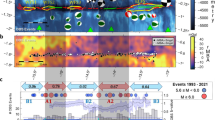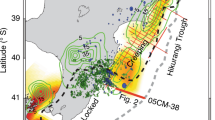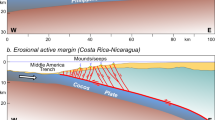Abstract
Slow earthquakes occur at the plate interface in subduction zones. These low-frequency tremors and slow-slip events are often located at about 30 km depth1,2,3, near the boundary between the crust and mantle (Moho) on the overriding plate. Slow earthquakes occur on fault patches with extremely low frictional strength4,5,6. This weakness is generally assumed to result from increased pore-fluid pressures and may be linked to the release of fluids from the descending plate. Here we propose that a contrast in permeability across the Moho results in the accumulation of water and the build-up of pore-fluid pressure at the corner of the mantle wedge that overlies the subducting plate. We use laboratory measurements of permeability to show that gabbroic rock layers in the crust are two orders of magnitude less permeable than serpentinite layers in the underlying hydrated mantle rocks. Inserting our experimental data into a numerical model that simulates pore pressure evolution across the Moho, we show that the pore-fluid pressure at this boundary can be as high as lithostatic pressure. We suggest that water released from the descending plate is trapped at the corner of the mantle wedge owing to this permeability barrier, and then causes the localized slow earthquakes that are triggered by fault instabilities.
This is a preview of subscription content, access via your institution
Access options
Subscribe to this journal
Receive 12 print issues and online access
$259.00 per year
only $21.58 per issue
Buy this article
- Purchase on Springer Link
- Instant access to full article PDF
Prices may be subject to local taxes which are calculated during checkout




Similar content being viewed by others
References
Shelly, D. R., Beroza, G. C., Ide, S. & Nakamula, S. Low-frequency earthquakes in Shikoku, Japan and their relationship to episodic tremor and slip. Nature 442, 188–191 (2006).
Matsubara, M., Obara, K. & Kasahara, K. Three-dimensional P- and S-wave structures beneath the Japan Islands obtained by high-density seismic stations by seismic tomography. Tectonophysics 454, 86–103 (2008).
Abers, G. et al. Imaging the source region of Cascadia tremor and intermediate-depth earthquakes. Geology 37, 1119–1122 (2009).
Obara, K. Nonvolcanic deep tremor associated with subduction in southwest Japan. Science 296, 1679–1681 (2002).
Kodaira, S. et al. High pore fluid pressure may cause silent slip in the Nankai trough. Science 304, 1295–1298 (2004).
Ito, Y., Obara, K., Shiomi, K., Sekine, S. & Hirose, H. Slow earthquakes coincident with episodic tremors and slow slip events. Science 315, 503–506 (2007).
Terzaghi, K. & Peck, R. B. Soil Mechanics in Engineering Practice (Wiley, 1967).
Rice, J. R. in Fault Mechanics and Transport Properties of Rocks (eds Evans, B. & Wong, T.) 475–504 (Academic, 1992).
Schmidt, M. W. & Poli, S. Experimentally based water budgets for dehydrating slabs and consequences for arc magma generation. Earth Planet. Sci. Lett. 163, 361–379 (1998).
Katayama, I., Hirauchi, K., Michibayashi, K. & Ando, J. Trench-parallel anisotropy produced by serpentine deformation in the hydrated mantle wedge. Nature 461, 1114–1117 (2009).
Kawano, S., Katayama, I. & Okazaki, K. Permeability anisotropy of serpentinite and fluid pathways in a subduction zone. Geology 39, 939–942 (2011).
Magoon, L. B. & Dow, W. G. in The Petroleum Systems—From Source to Trap Vol. 60 (eds Magoon, L. B. & Dow, W. G) 3–24 (AAPG Memoir, 1994).
Audet, P., Bostock, M. G., Christensen, N. I. & Peacock, S. M. Seismic evidence for overpressured subducted oceanic crust and megathrust fault sealing. Nature 457, 76–78 (2009).
Peacock, S. M., Christensen, N. I., Bostock, M. G. & Audet, P. High pore pressures and porosity at 35 km depth in the Cascadia subduction zone. Geology 39, 471–474 (2011).
Kato, A. et al. Variation of fluid pressure within the subducting oceanic crust and slow earthquakes. Geophys. Res. Lett. 37, L14310 (2010).
Tanikawa, W. & Shimamoto, T. Comparison of Klinkenberg-corrected gas permeability and water permeability in sedimentary rocks. Int. J. Rock Mech. Min. Sci. 46, 229–238 (2009).
Klinkenberg, L. J. The Permeability of Porous Media to Liquids and Gases 200–213 (American Petroleum Institute Drilling and Production Practice, 1941).
Scheidegger, A. E. The Physics of Flow Through Porous Media 3rd edn (Univ. Toronto Press, 1974).
Bernabe, Y., Mok, U. & Evans, B. Permeability-porosity relationships in rocks subjected to various evolutions processes. Pure Appl. Geophys. 160, 937–960 (2003).
David, C., Wong, T. F., Zhu, W. & Zhang, J. Laboratory measurement of compaction-induced permeability change in porous rocks: Implications for the generation and maintenance of pressure excess in the crust. Pure Appl. Geophys. 143, 425–456 (1994).
Walder, J. & Nur, A. Porosity reduction and crustal pore pressure development. J. Geophys. Res. 89, 11539–11548 (1984).
Wong, T. F., Ko, S. C. & Olgaard, D. L. Generation and maintenance of pore pressure excess in a dehydrating system 2. Theoretical analysis. J. Geophys. Res. 102, 841–852 (1997).
Brown, J. R. et al. Deep low-frequency earthquakes in tremor localize to the plate interface in multiple subduction zones. Geophys. Res. Lett. 36, L19306 (2009).
Furukawa, F. Convergence of aqueous fluid at the corner of the mantle wedge: Implications for a generation mechanism of deep low-frequency earthquakes. Tectonophysics 469, 85–92 (2009).
Obara, K. & Hirose, H. Non-volcanic deep low-frequency tremors accompanying slow slips in the southwest Japan subduction zone. Tectonophysics 417, 33–51 (2006).
Seno, T., Sakurai, T. & Stein, S. Can the Okhotsk plate be discriminated from the North American plate? J. Geophys. Res. 101, 11305–11315 (1996).
Hirose, F., Nakajima, J. & Hasegawa, A. Three-dimensional seismic velocity structure and configuration of the Philippine Sea slab in southwestern Japan estimated by double-difference tomography. J. Geophys. Res. 113, B09315 (2008).
Nakajima, J., Matsuzawa, T., Hasegawa, A. & Zhao, D. Three-dimensional structure of Vp, Vs and Vp/Vs beneath northeast Japan: Implications for arc magmatism and fluids. J. Geophys. Res. 106, 21843–21857 (2001).
Sano, Y. & Wakita, H. Geographical distribution of 3He/4He ratios in Japan: Implications for arc tectonics and incipient magmatism. J. Geophys. Res. 90, 8729–8741 (1985).
Umeda, K., McCrank, G. F. & Ninomiya, A. Helium isotopes as geochemical indicators of a serpentinized fore-arc mantle wedge. J. Geophys. Res. 112, B10206 (2007).
Acknowledgements
We thank T. Shimamoto for technical advice, and S. Kawano for assistance in conducting the experiments. Comments from and discussions with K. Hirauchi, M. Takahashi and J. Nakajima provided the motivation for this study. We also thank T. Nishiyama for advice regarding the serpentinite sample locality. This study was supported by the Japan Society for the Promotion of Science and a Grant-in-Aid of Science Research on the Innovative Area of Geofluids.
Author information
Authors and Affiliations
Contributions
I.K. planned the project. I.K., T.T. and K.O. conducted experiments and W.T. performed numerical modelling. All authors discussed the results and their implications.
Corresponding author
Ethics declarations
Competing interests
The authors declare no competing financial interests.
Supplementary information
Supplementary Information
Supplementary Information (PDF 764 kb)
Rights and permissions
About this article
Cite this article
Katayama, I., Terada, T., Okazaki, K. et al. Episodic tremor and slow slip potentially linked to permeability contrasts at the Moho. Nature Geosci 5, 731–734 (2012). https://doi.org/10.1038/ngeo1559
Received:
Accepted:
Published:
Issue Date:
DOI: https://doi.org/10.1038/ngeo1559



